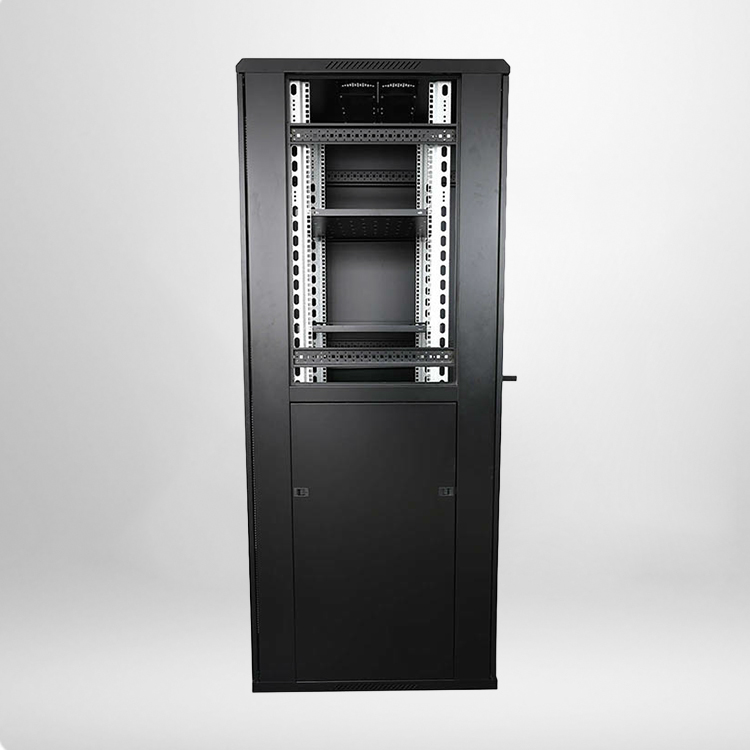
Standing network cabinets, also known as floor-mounted network cabinets, are robust, freestanding enclosures designed to house and manage large volumes of networking and IT equipment. Unlike wall-mounted alternatives, these cabinets leverage vertical space and heavy-duty construction to support complex setups—making them indispensable for data centers, enterprise offices, server rooms, and other environments requiring high equipment density.
The structural design of standing network cabinets is engineered for durability and functionality. Most models feature a rigid frame crafted from cold-rolled steel, with a load-bearing capacity ranging from 800 to 2000 pounds—enough to support multiple servers, switches, routers, UPS systems, and patch panels. Height is a key characteristic, typically measured in “rack units” (1U = 1.75 inches), with common sizes spanning 42U (73.5 inches) to 48U (84 inches) to accommodate tall equipment. Many cabinets include adjustable mounting rails, allowing flexible placement of devices of varying heights, while removable side panels and front/rear doors (often tempered glass or steel) provide easy access for installation and maintenance. Ventilation is another critical design element: integrated fans, vented doors, or blanking panels ensure consistent airflow, preventing equipment overheating—a major risk in high-density setups. Some advanced models also include built-in cable management channels, cable organizers, and brush strips to route wires neatly, reducing clutter and simplifying troubleshooting.
Performance-wise, standing network cabinets excel at protecting equipment and optimizing system reliability. Their enclosed structure shields gear from dust, debris, and accidental physical damage, while lockable doors restrict unauthorized access—essential for safeguarding sensitive data and preventing tampering. For environments with strict temperature or humidity requirements, cabinets may offer IP (Ingress Protection) ratings (such as IP65 for dust-tight and water-resistant designs) or compatibility with cooling systems like in-row air conditioners. Additionally, the vertical layout of standing cabinets maximizes floor space efficiency: a single 42U cabinet can replace multiple smaller enclosures, freeing up area for other infrastructure while centralizing equipment management. This centralization also simplifies cable tracing and device monitoring, as technicians can access all components from a single location.

When selecting a standing network cabinet, several key factors should guide the decision. First, equipment density and weight: calculate the total number of devices, their combined weight, and dimensions to ensure the cabinet’s load capacity and internal space align with needs. For example, heavy servers may require reinforced shelves or cabinets with higher weight ratings. Second, environmental conditions: in data centers or server rooms, prioritize cabinets with advanced cooling features or compatibility with existing HVAC systems; in industrial settings, opt for dust-resistant or waterproof models. Third, future scalability: choose a cabinet with extra rack units to accommodate new equipment as the network grows—this avoids the need for frequent replacements. Fourth, cable management needs: look for cabinets with built-in channels, tie-down points, or cable management arms to keep wires organized, as poor cable management can hinder airflow and increase maintenance time.
Installation and maintenance best practices are vital for maximizing the cabinet’s lifespan and performance. During installation, place the cabinet on a level, stable surface (preferably a raised floor in data centers to facilitate under-floor cable routing and cooling). Ensure there is at least 30 inches of clearance around the cabinet for airflow and technician access, and secure the cabinet to the floor or wall (using anti-tip brackets) to prevent tipping, especially in high-traffic areas. When mounting equipment, distribute weight evenly across the cabinet to avoid strain on the frame, and use blanking panels to fill empty rack units—this maintains proper airflow by preventing air bypass. For maintenance, regularly inspect cooling systems (cleaning fans or replacing air filters) and check for loose cables or signs of equipment overheating. Periodically tighten mounting screws to ensure devices remain secure, and keep the cabinet interior free of dust with gentle vacuuming.


